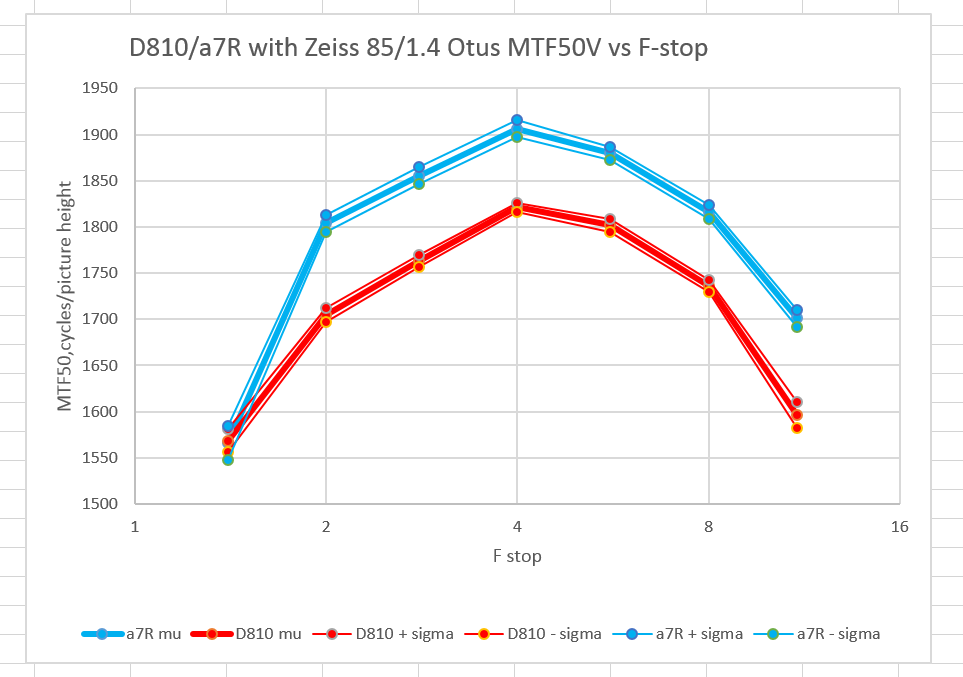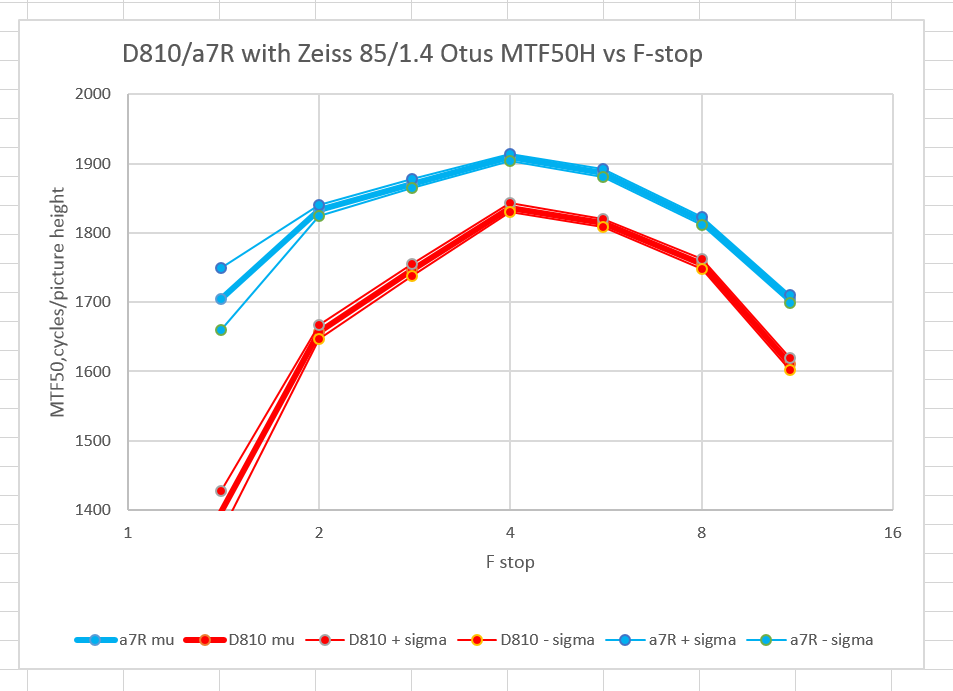[Warning: the data presented in this post is highly misleading because of he way that Lightroom sharpens during raw development, For a truer picture, read the next post.]
There have been discussions on the ‘net recently about the proposition — considered proven by some — that the resolution of the Nikon D810 is superior to that of the alpha 7R (a7R), even though the pixel count of the two cameras is the same, and neither of them have anti-aliasing (AA, pronounced A-squared) filters.
My own thinking has been that any resolution deficiencies of the a7R probably related to shutter shock, since the a7R offers neither a delay between winding and tripping the shutter, nor electronic first curtain shutter (EFCS).
But it is an interesting proposition, and one that I attempted to test in a way that removes shutter shock from the equation.
I set up a D810 in landscape orientation using a RRS L-bracket on an Arca Swiss C1 cube head attached to a set of RRS TVC-43 legs. I mounted a Zeiss 55mm f/1.4 Otus.
- The lighting: a single Paul Buff Einstein 640 watt-second smart strobe. The room was darkened otherwise, except for focusing, which was done with a Fotodiox LED light of the same color temperature as the strobe.
- ISO set to 100, f-stop set to f/1.4.
- Focusing manually at f/1/4, using the magnifier. The focus point is a Siemens star on an Imatest slanted-edge target.
- Shutter delay set to 3 seconds
- EFCS on, dial to Mup
- Strobe to 10 ws, shutter to 1/320 second, make 16 exposures, turn the strobe up a stop, make 16 exposures… until you get to f/11 and 640 watt-seconds.
- Mount the lens on an a7R.
- Set the camera for rear-curtain synch, and the shutter speed to 1/30 second, to let the first-curtain vibrations die down.
- Repeat exposure sequence.
- Develop in Lightroom 5.7.1 with standard settings.
- Crop, export as TIFFs, analyze for horizontal edge and vertical edge MTF50 in Imatest.
- Export the results to Excel, crunch the stats, and graph.
Here are the results for the vertical edge:
The solid lines are the average of the MTF50 values for the 16 exposures, measures in cycles per picture height. The light lines are the averages plus and minus one standard deviation. The spread is very tight.
I expected the curves to be pretty much the same, but the D810 curve is actually worse than the a7R curve. Not by much, but certainly enough to be undeniably statistically significant. It doesn’t look like a focusing error — which is easy to make with such a fine, fast, lens — since the f/1.4 points are essentially the same.
Here are the curves for the horizontal edges:
The a7R curve at f/1.4 is substantially better than for vertical edges. The D810 curve is worse at f/1.4. Otherwise, they’re pretty much the same.
[Added: Lr does some funny things without informing the user. One of them is to apply sharpening based on the camera and the lens. This fun-loving program will do that even if you turn sharpening off. When I mounted the Otus on the D810, the camera passed the lens data and the f-stop to the metadata, and Lr apparently looked at that metadata and was gentle with the sharpening. When I mounted the Otus on the a7R with an adapter, Lr had no idea what lens was on the camera, or what f-stop it was set to. So it applied some kind of generic sharpening, which, as it turns out, was pretty aggressive.]


Wow, what a weird result. Can you use a different RAW converter, perhaps something very plain like RAWdigger or MakeTIFF, to see if there’s something in the RAW conversion that’s affecting the results?
Andre, turns out you are right. Results are different with DCRAW/AHD.
Jim
Hi Jim,
I welcome the independent testing and comparison. My results to date are different so I think it’s important to go into my set up and process.
1. Stable surface for both the chart and tripod.
2. Align chart to sensor and center. This is important for telephotos and critical for wides and insane for super wides. (all of the tests so far only use center scores).
3. I shoot in the highest quality raw available to me for each camera. As well, I take care to ensure there is enough light that Sony’s shutter shake doesn’t become a factor during the test (especially important with an aperture series ending at f8-f11). Today it was seriously nice and bright and without adding ND filters f4 was the lower limit on both of these cameras.
(Zeiss’s outrageously good transmission also a factor.)
4. Import into capture 1 (my default settings include C1’s sharpening (I’m too lazy to turn it off and too forgetful to turn it back on.) The Sony and Nikon files get equal treatment so it’s apples to apples.
5. In C1, I then ETTR the histogram via exposure until the files all have the same appx histogram. No extra sharpening, clarity, contrast, etc.
Additional Notes –
1. To eliminate the A7r shutter shock I typically have done these tests with enough light to ensure high shutter speeds.
2. I often use a 4k monitor to achieve critical focus for each test. In yesterday’s test a 3x loupe on the Nikon and the magnified view. The Sony at 14.4x.
3. I use the live preview button on the Nikon during the focus sequence even with the Otus (except when wide open).
All of my A7r / D810 comparisons have been shot at f 4.0.
Making the assumption that if something is at fault it’s most likely me, I often walk around to the front of the camera to make sure the aperture is really and for certain not wide open while I am focusing the Nikon. With the A7r I know it is (sometimes) but also check because the Novoflex adapter has been in the wrong position at times.
One of the differences may be C1 and the fact that I’ve left import sharpening on since I first began using the program. (style – pre sharpening 1)
This has resulted in questionable results for some time as the upper figure in many of my Imatest results (especially in overall high scores) is greater than the lower figure which never was the case prior to using C1.
I plan to repeat the test without C1 sharpening.
1/500 isn’t fast enough to completely tame a7R shutter shock with the Zony 55:
http://blog.kasson.com/?p=4750
It will take a faster shutter speed with longer lenses.
Jim
I refocus between every shot. Even when at the same f stop for the series.
Do you focus once at f 1.4 and then run the test across all of the stops?
I only use 1 ROI in these tests – usually the vertical right edge slant closest to center. They are typically less than 5% from center. Yesterday 3.3% and 2.0% from center.
I focus once at the beginning. There are over 200 shots in the series; life’s too short to focus for every one of them. If I’m off, I’ll see a lot of MTF50 falloff at f/1.4.
I focus on the Siemens star and use the vertical edge right next to it and the lower side of the same square as the horizontal edge. I put that square in the center of the image.
Jim
I believe there is some focus shift even with the Otii.
I agree life is too short so I limit to 3 shots in a series (for each setting) and typically at F4 because it’s just the best f stop ever. 🙂
I once documented ‘shot acquisition’ intervals between the Sony A7r and D810 while using the Apo-Sonnar. Despite being new to the 810, critical focus acquisition was quicker with the Nikon.
https://sonyvnikon.files.wordpress.com/2015/02/sony-a7r-and-nikon-d810-with-apo-135mm.jpg
Next time I am set up I’ll try to quantify what the differences are. (Mainly the result of focusing the D810 with and without the live preview button activated).
Of course, walking around to the front of the camera will negatively impact acquisition timing. LOL
https://sonyvnikon.wordpress.com/2015/05/29/a-quantatative-test-done-by-a-guru-shows-a7r-sharper-than-d810/
PS: You’re the guru but I actually feel like I poked a grizzly. 🙂
And there’s one more new variable in the mix. I upgraded the Sony to rev 1.2 today. Could that be the difference ?
Max, thanks for all the comments. Together, I’m sure we can get to the bottom of this. It’s fun to have a mystery to work on.
Jim
Max, I ain’t no grizzly, just somebody who got a different answer. We’ll work it out.
Tomorrow, the first think I’m gonna try is either a different raw converter or working on one of the green channels in the raw files (Jack Hogan, I can hear you saying “I told you so”.)
Then I’ll explore alignment, but I know the tripod didn’t move much at all when I swapped cameras, so, while I can see that alignment could have been off, it wasn’t differentially off unless the difference in focal plane location of the two cameras is significant.
The next think is to make the strobe triggering and the shutter speed the same, but now I think we’re grasping for straws.
One thing I’m sure of — we’ll get this figured out.
Jim
I tested focus shift
https://sonyvnikon.wordpress.com/2015/06/24/focus-shift-study-nikon-d810-with-otus-55mm/